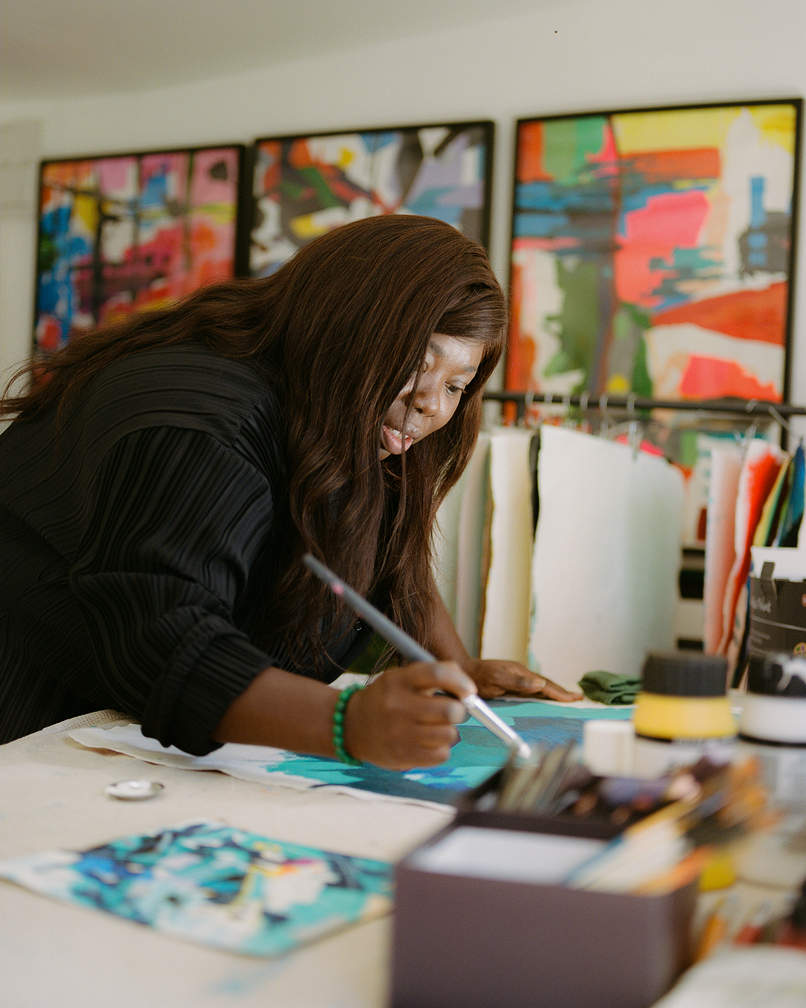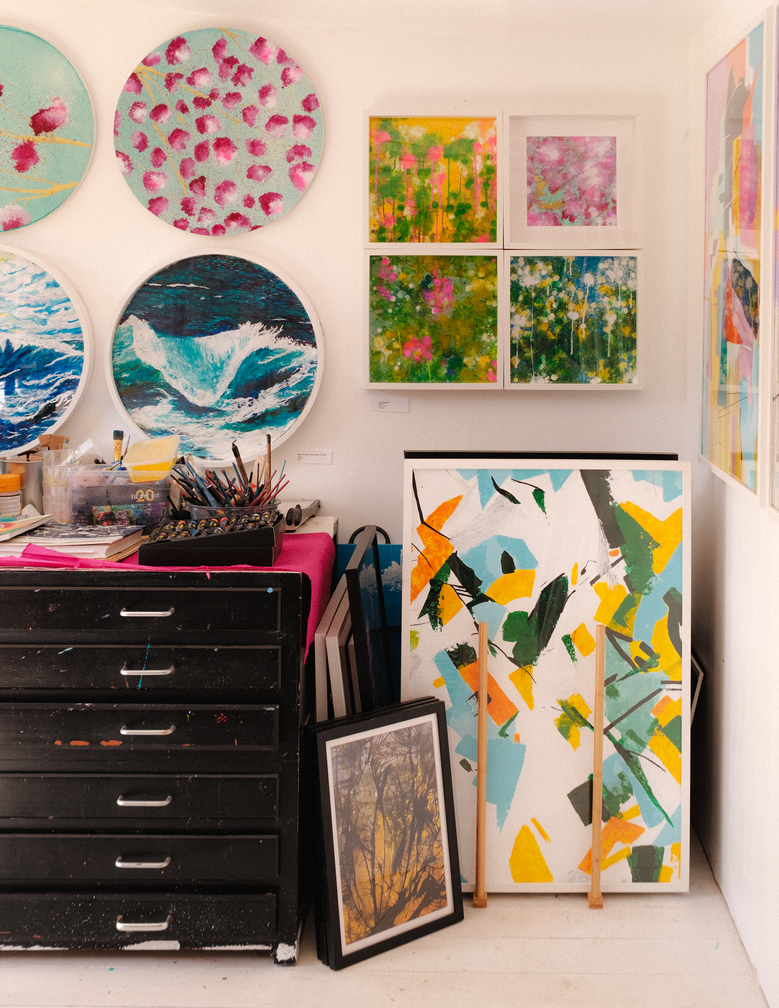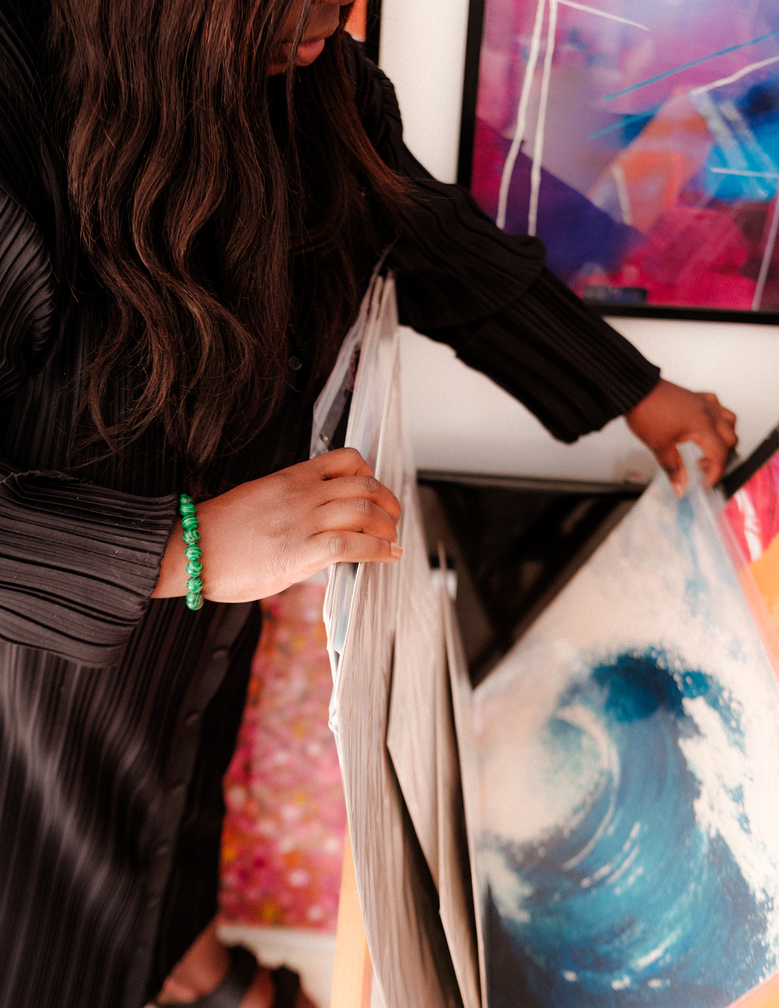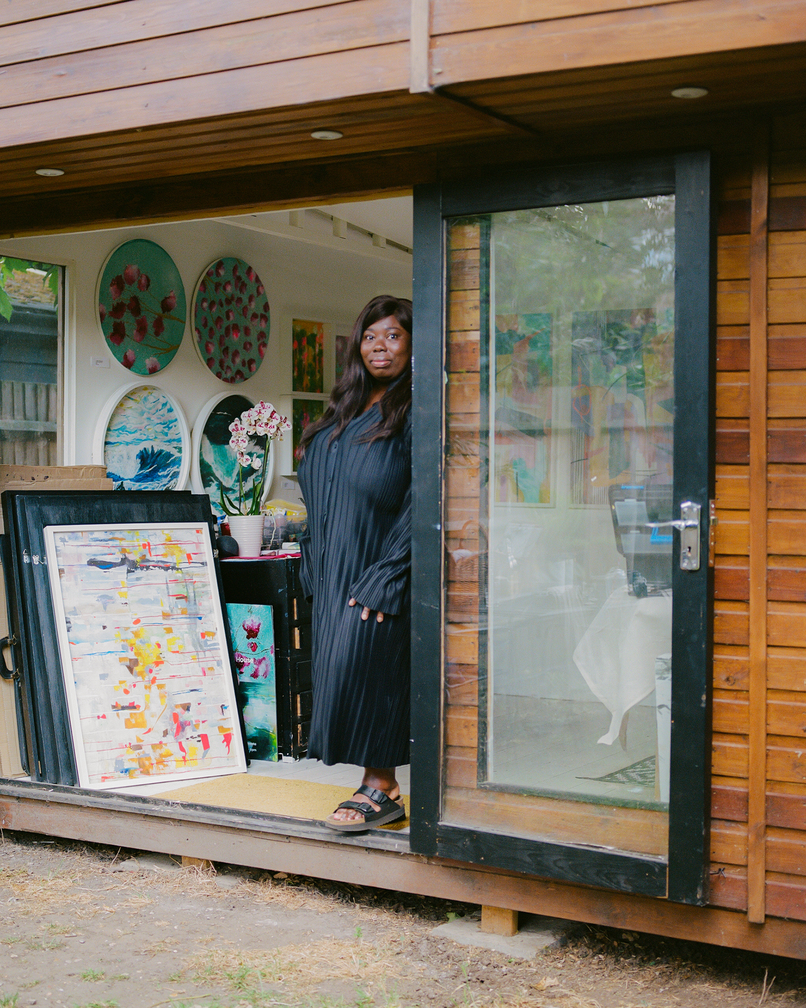article In conversation with
Courtenay Kusitor
In conversation with
Courtenay Kusitor
Courtenay Kusitor

In conversation with Courtenay Kusitor
about colour, consciousness and the
humble cotton rag.
about colour, consciousness and the
humble cotton rag.
In conversation with Courtenay Kusitor
about colour, consciousness and the
humble cotton rag.

Courtenay Kusitor is a British Ghanaian abstract artist whose impressionist and expressionist paintings are informed by her exploration of human consciousness. Using bold colours and intuitive marks her works invite their viewers to contemplate the depths of human awareness.
Evolving from a childhood love of calligraphy, she predominantly works with inks on sustainable, handmade paper.
Evolving from a childhood love of calligraphy, she predominantly works with inks on sustainable, handmade paper.

Artiq You often work with a bright, bold colour palette. What draws you to these colours and the use of them in large blocks?
Courtenay I think that there are two main reasons for this. The first is my heritage. I’m Ghanaian, and our cultural fabric is Kente cloth, a beautifully woven material focused on colour and symbolism. The colours are largely contrasting and woven in blocks. As a young girl, I loved watching my mum dress up; she was never afraid of colour. I think this was my first experience of how colour can speak to us.
Secondly, I suffered a head injury in my 30s and was unconscious for about six minutes. During recovery, I discovered the power of awareness and living in the present moment. Everything was louder and more vibrant, and I noticed much more than before. I take pictures to refer to while creating works. Nature offers a kaleidoscope of colours; we only need to take notice.
Courtenay I think that there are two main reasons for this. The first is my heritage. I’m Ghanaian, and our cultural fabric is Kente cloth, a beautifully woven material focused on colour and symbolism. The colours are largely contrasting and woven in blocks. As a young girl, I loved watching my mum dress up; she was never afraid of colour. I think this was my first experience of how colour can speak to us.
Secondly, I suffered a head injury in my 30s and was unconscious for about six minutes. During recovery, I discovered the power of awareness and living in the present moment. Everything was louder and more vibrant, and I noticed much more than before. I take pictures to refer to while creating works. Nature offers a kaleidoscope of colours; we only need to take notice.

Artiq The titles of your works are striking, including: ‘There Is A Power In Being Courageous’ , ‘Joy Lives Here’ and ‘You, The Powerful Creator’. What is your process when naming your works? At what point in the making process do you name the piece?
Courtenay As part of my recovery from the injury, I experienced what psychologists call post-traumatic growth. I had many questions about my accident and really wanted to understand what had happened. I started listening to TED Talks, seminars, and podcasts about the human condition. This led me down the wonderful rabbit hole of consciousness and eventually to neuroscience. My titles are usually based on the audio I was listening to while creating the work. I get an “aha!” moment, something that really resonates with me, and jot it down to rework for the title. The concepts for the titles can come to me anytime during the listening process, so I make sure to stop and jot them down. Other times, they might come from a conversation I’m having or a sentence from a movie, but they are always connected to consciousness.
Courtenay As part of my recovery from the injury, I experienced what psychologists call post-traumatic growth. I had many questions about my accident and really wanted to understand what had happened. I started listening to TED Talks, seminars, and podcasts about the human condition. This led me down the wonderful rabbit hole of consciousness and eventually to neuroscience. My titles are usually based on the audio I was listening to while creating the work. I get an “aha!” moment, something that really resonates with me, and jot it down to rework for the title. The concepts for the titles can come to me anytime during the listening process, so I make sure to stop and jot them down. Other times, they might come from a conversation I’m having or a sentence from a movie, but they are always connected to consciousness.

Artiq You work on both paper and canvas. Can you discuss the different approaches you take to the materiality of each?
Courtenay They are both made from cotton but handmade cotton rag - which is the paper I use comes in a very heavy and rough finish - almost like a stiff fabric. This allows me to create texture and works really compliments my casted mark making style. When my work requires a smooth and more precise finish, that’s when I switch to canvas. .
Artiq How does the use of your handmade paper factor into your practice? Can you tell us more about how you got into this process?
Courtenay I was obsessed with calligraphy as a child. I loved the way ink flowed on paper and would get calligraphy sets that included quality paper. I really enjoyed how the ink would soak into the paper. In art school, we made our own cotton rag and created sheets of varying thicknesses. I loved the imperfections, rawness, and grittiness of the paper, and that appreciation has stayed with me ever since, I can’t imagine my art practice without the use of cotton rag.
Courtenay They are both made from cotton but handmade cotton rag - which is the paper I use comes in a very heavy and rough finish - almost like a stiff fabric. This allows me to create texture and works really compliments my casted mark making style. When my work requires a smooth and more precise finish, that’s when I switch to canvas. .
Artiq How does the use of your handmade paper factor into your practice? Can you tell us more about how you got into this process?
Courtenay I was obsessed with calligraphy as a child. I loved the way ink flowed on paper and would get calligraphy sets that included quality paper. I really enjoyed how the ink would soak into the paper. In art school, we made our own cotton rag and created sheets of varying thicknesses. I loved the imperfections, rawness, and grittiness of the paper, and that appreciation has stayed with me ever since, I can’t imagine my art practice without the use of cotton rag.

Artiq In many of your pieces, you create movement through geometric and organic lines. Can you talk about the use of line within your work?
Courtenay I think order and chaos play into the human condition. Life seems to be a constant juggle. It feels like everyone is looking to get their life in order, to become a better version of themselves, to fix what is wrong. We generally think too much, planning ahead rather than living in the now and accepting life for what it has to offer us in this moment.
It’s only recently that I have noticed the chaos in my early works. This was me trying to work through things, to make sense of my new direction in life. I now use the lines to connect one section of a painting to another, representing the interconnectedness and the ebb and flow of life. Geometry is my order I guess; I use blocks (although imperfect) to order my thoughts.
Courtenay I think order and chaos play into the human condition. Life seems to be a constant juggle. It feels like everyone is looking to get their life in order, to become a better version of themselves, to fix what is wrong. We generally think too much, planning ahead rather than living in the now and accepting life for what it has to offer us in this moment.
It’s only recently that I have noticed the chaos in my early works. This was me trying to work through things, to make sense of my new direction in life. I now use the lines to connect one section of a painting to another, representing the interconnectedness and the ebb and flow of life. Geometry is my order I guess; I use blocks (although imperfect) to order my thoughts.

Artiq You recently took part in our "Journey Through Time Trail" in collaboration with London Heritage Quarter. Can you discuss your commission for this project? What do you hope your audience takes away from seeing your piece?
Courtenay I want my colourful abstract teapot to stop a passerby in their tracks, grab their attention, cause intrigue or curiosity, and offer a little joy or a smile—even if just for a few seconds. If my art can tempt a viewer to stop and be present, my work is done.
Artiq Do you have any upcoming projects you would like to share?
Courtenay I have recently taken part in Landscape Artist of The Year as one of 50 wildcard artists. It will air in January 2025 on Sky Arts.
My works have also been selected for the ArtCan Summer Exhibition - Fiesta running from 3rd to 14th July in Hackney Wick and Flux Exhibition from 25th - 28th July in Marylebone.
Courtenay I want my colourful abstract teapot to stop a passerby in their tracks, grab their attention, cause intrigue or curiosity, and offer a little joy or a smile—even if just for a few seconds. If my art can tempt a viewer to stop and be present, my work is done.
Artiq Do you have any upcoming projects you would like to share?
Courtenay I have recently taken part in Landscape Artist of The Year as one of 50 wildcard artists. It will air in January 2025 on Sky Arts.
My works have also been selected for the ArtCan Summer Exhibition - Fiesta running from 3rd to 14th July in Hackney Wick and Flux Exhibition from 25th - 28th July in Marylebone.